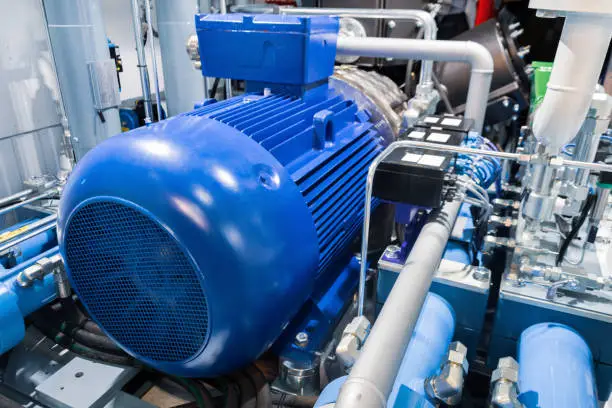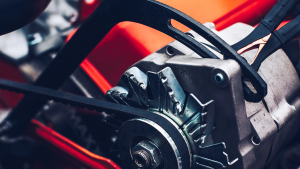Cutting edge energy efficient motors integrate advancements that boost their functionality. These motors commonly showcase refined rotor structures and enhanced stator setups, alongside optimized components that minimize energy wastage. A significant improvement lies in incorporating magnets in motors to enhance efficiency across different load scenarios. Moreover; such motors frequently feature control technologies like frequency drives (VFDs), for efficient motor speed and torque control to maximize energy conservation efforts. The ongoing development of these technologies has established high-efficiency motors as components, in industrial energy solutions.

One of the advantages of high-efficiency energy-saving motors is the cost savings gained from using less electricity due, to their improved efficiency compared to traditional motors for performing tasks efficiently and effectively over time. Moreover in a scenario where energy expenses are steadily increasing, for high-efficiency motors can act as a safeguard against price hikes making them a viable option, for sectors looking to boost their profit margins.
Utilizing energy motors plays a role, in promoting environmental sustainability by cutting down on energy use and curbing greenhouse gas emissions significantly; these motors are designed to minimize energy wastage and reduce carbon footprint compared to conventional ones effectively. Moreover, employers can showcase their commitment to eco practices by adopting motor technologies, which helps them comply with stricter environmental regulations set by authorities. This does not benefit the environment. Also enhances the company’s reputation, among consumers who value sustainability.
The use of performance energy motors is crucial, for cutting down on carbon emissions in different industries significantly. By improving the energy efficiency of systems powered by motors industries can greatly lessen their dependence on fuels in areas where energy production is highly polluting with carbon. This leads to a drop, in the emissions linked to industrial operations throughout their lifecycle, which helps support worldwide initiatives to address climate change. As businesses move towards friendly options, in their operations incorporating high-performance motors helps establish them as frontrunners, in promoting sustainability efforts.
High-efficiency energy-saving motors offer more than cost savings and environmental advantages – they also deliver performance and reliability that can boost industrial productivity overall. Their advanced design enables them to operate under load conditions while reducing the likelihood of breakdowns and downtime. The reliability of these motors is typically attributed to their high-quality construction and materials used in manufacturing them which ensures performance for applications. Furthermore, implementations of technologies allow for extended maintenance intervals resultin, in reduced maintenance expenses and enhanced efficiency.

Enneng has positioned itself as a contributor, in the realm of efficient energy-saving motor technology since its beginning days in the industry sector. Founded with the aspiration to revolutionize the motor field Enneng has concentrated on progressing motor technologies that prioritize energy efficiency and eco-friendliness.Their dedication to originality is steered by a goal to provide state-of-the-art solutions that not just boost efficiency but resonate, with worldwide energy conservation campaigns. Enthusiastic commitment, to advancement has empowered Enneng to contribute to the evolution of motor technologies by engaging in research efforts and innovative design and application practices.
Enneg follows principles focusing on excellence, intelligence, and durability. These principles are integrated into all areas of their business operations ranging from creating products to serving customers. The organization embraces an outlook striving to enhance energy motor technologies in response, to the evolving needs of the industry. Enneng imagines a future where eco-friendly motors are commonly used in fields promoting an industrial environment that emphasizes minimizing environmental harm and improving operational efficiency.
Enneng offers a variety of energy-saving motors for various industrial needs, with precision engineering to optimize energy consumption across different settings such as synchronous and asynchronous motors as well, as servo motors that cater to specific industry demands by utilizing cutting-edge technology and advanced engineering methods to enhance performance and save energy efficiently.
Enneng’s high-efficiency energy-saving motors are built with top-notch engineering and a dedication, to quality that shines through in their specifications. Featuring cutting-edge rotor designs and optimized circuits that significantly reduce energy losses these motors include characteristics like integrated variable frequency drives (VFDs) allowing for precise speed control and increased efficiency even when dealing with varying loads. Enneng places an emphasis on durability and reliability to ensure that their motors not only operate efficiently but also have longer lifespans resulting in lower overall costs, for their clients over time.

The field of energy motor technology is always changing with different new trends that impact how motors are designed and operated. The advancements, in motor technologies are leading the way by enabling integration with Internet of Things (IoT) systems, for monitoring motor performance in time and analyzing data. This connection enables maintenance planning to improve reliability and reduce interruptions. Advancements, in fields, like materials science are also contributing to the development of more effective motor parts which are pushing the limits of what high-efficiency motors can accomplish further.
In the coming years ahead of us, we expect to see advancements, in energy-saving motor technology merging with energy sources like solar and wind power in a more seamless manner than ever before. Industries are progressively turning to wind energy solutions; therefore there is a growing need for motors that can efficiently function under varying energy conditions. Furthermore, the increasing focus on automation and smart manufacturing will create a demand for control systems that work hand in hand with high-efficiency motors. This integration won’t just help optimize energy consumption but also boost productivity across sectors paving the way for a phase, in manufacturing and industrial operations.
The integration of motors designed to save energy has wide-reaching economic effects, on various sectors of industry. These motors help companies cut down on their energy usage which in turn reduces their expenses and boosts their profit margins. This cost-saving measure enables businesses to divert resources towards ideas and expansion efforts thereby encouraging growth within the sector. Furthermore, the improved dependability and functionality of these motors enhance productivity enabling companies to increase output without an increase, in operating costs.
In today’s market scenario, effective energy-saving motors play a crucial role, in boosting competitive advantage for businesses. Embracing these technologies demonstrates a commitment to sustainability and innovation which can resonate well with both customers and stakeholders. Moreover, efficient motor systems often lead to product quality and longevity thus giving companies an edge over rivals who still use traditional motors. With sustainability emerging as a factor in distinguishing brands, in the market companies that embrace high-efficiency technology are likely to shine as industry leaders.
The advantages of integrating high-efficiency energy-saving motors go beyond saving money and enhancing operations in the short term, for industries that adopt these technologies. These firms can see enhancements in their impact over time as they contribute to global sustainability objectives. Moreover cultivating an ethos of energy efficiency can spark creativity and new methods, within companies fostering a mindset of development. In light of shifting concerns and evolving market needs, in the business world efficient motors will be essential to secure an eco-friendly future, for the industry.
